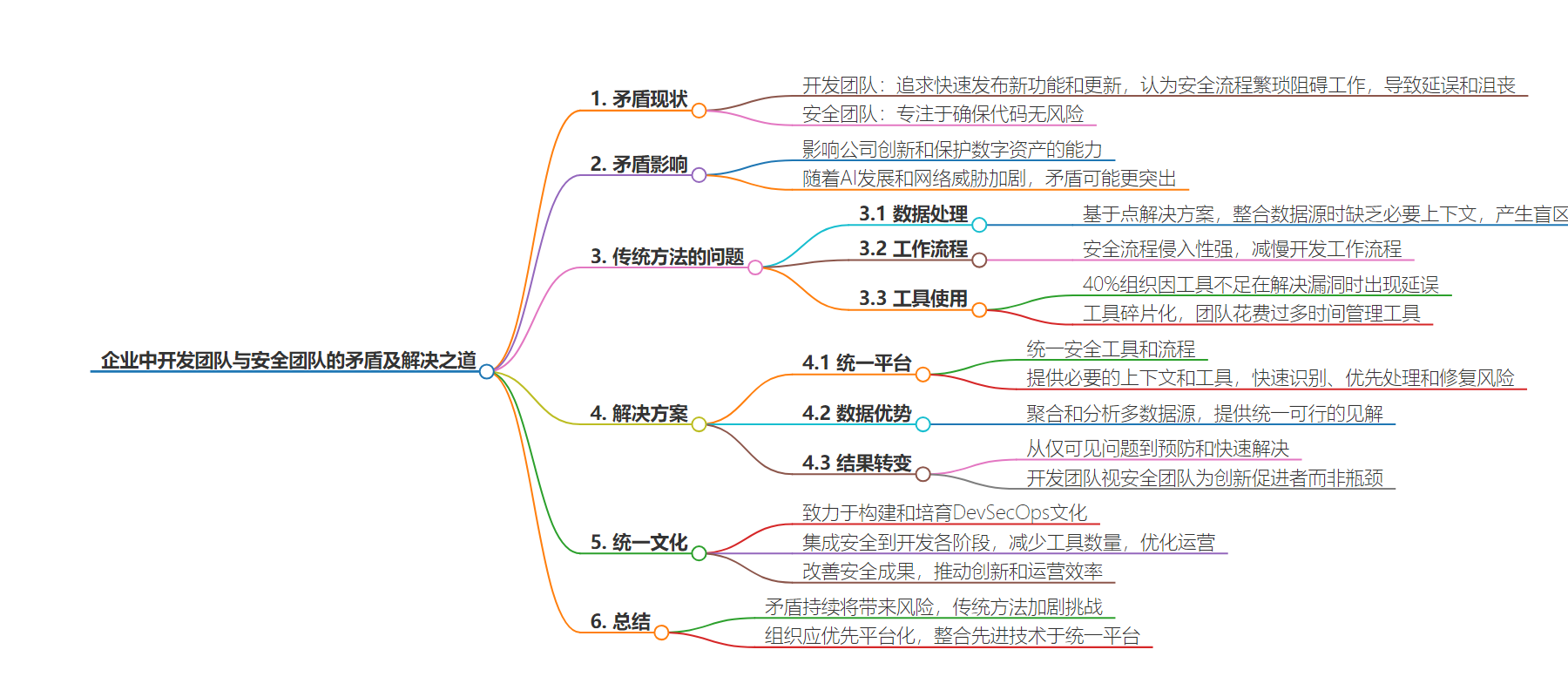包阅导读总结
1. 关键词:
– 开发者与安全团队
– 紧张关系
– 统一平台
– 协作文化
– 解决冲突
2. 总结:
企业中开发者与安全团队长期存在紧张关系,影响创新和数字资产保护。传统方法存在缺陷,统一的集成平台可解决此问题,促进协作,还需建立统一的 DevSecOps 文化,否则将带来风险,平台化是未来保障组织安全和发展的必要手段。
3. 主要内容:
– 企业中开发者和安全团队存在紧张关系,影响公司创新和数字资产保护
– 开发者追求快速发布新功能,认为安全流程繁琐
– 安全团队注重代码无风险,双方冲突随 AI 发展等加剧
– 传统方法存在问题
– 84%开发者认为安全流程致项目延迟,79%员工忽视安全流程
– 传统安全方案有盲点,工具碎片化致工作低效
– 统一平台是解决方案
– 提供数据优势,快速识别和解决风险
– 从检测到预防和快速解决,促进双方合作
– 需建立统一的 DevSecOps 文化
– 98%受访者认为应减少工具数量,平台化可优化安全态势
– 能改善关系,提高创新和运营效率
思维导图:
文章地址:https://thenewstack.io/platforms-can-finally-solve-developer-security-team-tension/
文章来源:thenewstack.io
作者:Idan Tendler
发布时间:2024/6/27 17:03
语言:英文
总字数:898字
预计阅读时间:4分钟
评分:81分
标签:DevOps,安全,平台化,DevSecOps,网络安全
以下为原文内容
本内容来源于用户推荐转载,旨在分享知识与观点,如有侵权请联系删除 联系邮箱 media@ilingban.com
In enterprise IT, there is a longstanding feud that doesn’t get the attention it deserves: the tension between developers and security teams. Driven by the need to release new features and updates continually, developers often perceive security processes as cumbersome and obstructive, leading to delays and frustration. Security teams, on the other hand, are focused on ensuring that every piece of code is robust and free of risk.
This conflict isn’t just minor workplace strains; it’s a fundamental clash of cybersecurity processes and priorities that directly affects a company’s ability to innovate and protect its digital assets. And with the rise of AI and increasingly sophisticated cyber threats, this tension is primed to intensify.
The only way to bridge the gap between developer and security teams is to unify their security tools and processes into a single, natively integrated platform.
Traditional Methods Demand a Modern Approach
Palo Alto Networks’ 2024 State of Cloud Native Security Report report found that 84% of developers attribute delays in their project timelines to security processes, and 83% view security as a “burden.” Perhaps more concerning, 79% of respondents to the report claim employees frequently ignore or work around security processes, leading to significant risks. An overwhelming 92% agreed that conflicting priorities for DevOps and cloud SecOps hinder efficient development and deployment, and 71% said that rushed deployments have introduced security vulnerabilities. These numbers provide a stark illustration of why this feud can be so damaging.
The real issue, though, isn’t the conflict itself but the methods and processes by which organizations work. Traditional security solutions, often based on point solutions, create blind spots by stitching together disparate data sources without providing the necessary context. Security processes become invasive and slow down the developer workflow, making them seem like roadblocks rather than safeguards.
Furthermore, 40% of organizations reported delays due to inadequate tooling when resolving bugs and vulnerabilities. The fragmented nature of these solutions forces developers and security teams to spend more time managing tools rather than focusing on their core responsibilities, further escalating the feud.
There is, however, a solution that aligns both teams toward a common goal. Unifying security tools and processes into a single, integrated platform will bridge the gap between development and security, fostering efficiency and collaboration. Providing the necessary context and tools for both teams to identify, prioritize and remediate risks quickly, transforms a contentious relationship into a productive partnership.
Fostering Collaboration, Relieving Tension
The urgency to implement platforms should be prompt, as the report highlighted that 95% of respondents desire solutions with immediate remediation steps. Platforms offer a tremendous data advantage that allows for quick remediation — aggregating and analyzing multiple data sources to create immediate unified actionable insights. So if there’s something detected in the network, it notifies the cloud, which then ties into security operations — all in unison.
Platformization excels in guiding teams directly to the “needle in the haystack,” as opposed to traditional methods that merely illuminate the haystack. This distinction is crucial. Unified platforms not only identify problems but also provide clear, actionable steps for remediation. This shift from mere visibility to prevention and rapid resolution is vital for maintaining robust security without hindering development speed.
By integrating numerous products and services into a natively integrated platform based on a common architecture, organizations can achieve both effectiveness (successfully fighting cyberattacks) and efficiency (getting the job done faster, with less complexity and in a more affordable way).
Unlike traditional methods that only provide visibility into problems, unified platforms guide users directly to the solution, offering prevention rather than just detection and providing critical context for both development and security teams. The result: developers view security teams as facilitators of innovation rather than bottlenecks to them.
Creating a Unified DevSecOps Culture
For platformization to be truly effective, organizations must commit to building and nurturing a DevSecOps culture. This requires deliberate and strategic efforts to integrate security into every stage of the development process. Without this commitment, businesses risk facing unresolved security vulnerabilities and inefficiencies that can negatively affect overall outcomes.
A comprehensive platform strategy can significantly reduce the number of tools in use, a necessity expressed by 98% of respondents in the Cloud Native Security Report. Integrating security tools into a single platform creates a more cohesive and effective security posture, streamlining operations and reducing complexity.
Platformization transforms the historically contentious relationship between developers and security teams into a collaborative partnership. This approach not only improves security outcomes but also drives innovation and operational efficiency. By fostering a unified DevSecOps culture, organizations can enhance their security measures while accelerating development, ultimately leading to better business results.
Conquering the Feud
If the feud between developers and security teams persists, it will continue to pose significant business operations and security risks. Furthermore, trusting traditional approaches that are reliant on point solutions will only serve to exacerbate these challenges.
It’s as simple as this: to effectively manage threats and enable developer and security teams to work together, organizations must prioritize platformization. It’s not just a matter of embracing advanced technologies, it’s about integrating them into a unified platform. Platformization isn’t a new feature or some company fad; it’s a necessity for future-proofing your organization’s security and development efforts.
YOUTUBE.COM/THENEWSTACK
Tech moves fast, don’t miss an episode. Subscribe to our YouTubechannel to stream all our podcasts, interviews, demos, and more.
